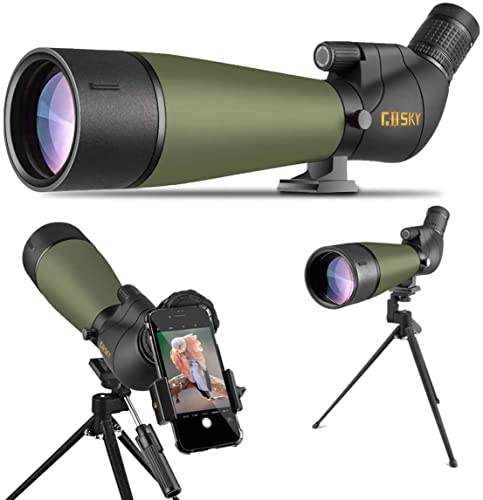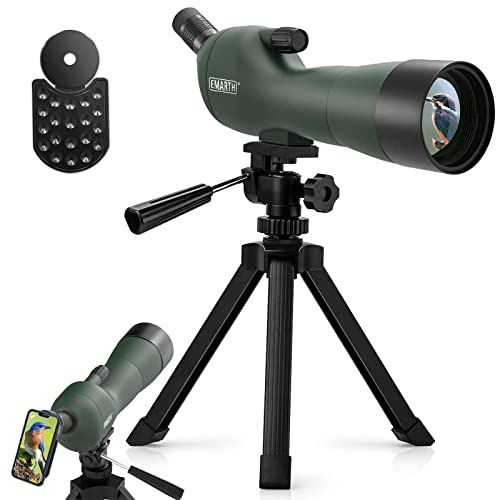Are you a devoted stargazer who believes that only telescopes can offer you the best celestial viewing experience? Well, it’s time to rethink that notion. You can use spotting scopes, often overlooked by astronomy hobbyists, which are versatile, portable, and capable of delivering strikingly clear views of both the night sky and Earthly vistas.
Below, I’ve rounded up the nine best spotting scopes for astronomy to enrich your starry-eyed explorations.
Table of Contents
Our top picks for a spotting scope for astronomy
If you are having a hard time deciding what spotting scope to purchase for your astronomy needs, you can choose from any of these recommendations:
Vortex Optics Razor HD Spotting Scope
Vortex Optics Razor HD is your best bet if you only care about the best spotting scope and don’t care about pricing. Thanks to its 85mm objective lens, you can see a great deal of detail in the sky and take some stunning images with your DSLR or mirrorless camera.
Even though it has a lot of glass and lens parts, it is very straightforward to use. Moreover, its visual quality sets it apart from its competitors. Because of its big, easy-to-grip focus ring that can be found even in complete darkness, this spotting scope makes it simple to quickly get the vital focus you need.
Pros
- Lightproof and portable
- Waterproof and fog proof
- With Armortrek coatings for extra protection against dirt and scratches
Cons
- No drawbacks mentioned
Orion 9823 Apex 102mm Maksutov-Cassegrain Telescope
One of Orion’s best products, the Apex Telescope, is well worth consideration when shopping for new equipment. When it comes to producing high-quality telescopes and optics, Orion has a long history. A good example of this is the Apex 102mm Telescope.
The closest competition to Orion is Celestron. It’s a Maksutov-Cassegrain with a hefty 102mm focal length. This has enough power to comfortably observe the moon, stars, and planets at night while simultaneously providing a small scope for daytime use.
With less than two feet in length and weighing a little more than five pounds, there is no need to worry about its weight.
Pros
- Also, has a soft carrying case included
- Lightweight and portable; great for on-the-go use
- Comes with an eyepiece with a 25mm Sirius Plossl 1.25′′ focal length
- Versatile; can be used for both terrestrial and astronomical purposes
- Includes finder scope with 626 correct-image resolution and 45-degree diagonal with correct-image alignment
Cons
- Doesn’t come with a tripod or a mounting system
Nikon Prostaff 5 Proscope
The Nikon Prostaff 5 is an extremely versatile spotting scope thanks to its magnification range of 20x to 60x and an 82mm objective lens, allowing you to observe large and small animals and celestial objects like the Moon or Jupiter.
This is an excellent spotting scope for those who value portability over bulk. Moreover, Nikon’s Coolpix digital compact cameras are compatible with the Prostaff 5, allowing you to assemble a portable digiscoping rig.
Pros
- Compact size and weight
- High-resolution optical system
- Comes with a carrying bag for ease of transport
- Has a built-in parasol to protect it from the sun’s rays.
Cons
- No drawbacks mentioned
Celestron C70 Mini Mak Spotting Scope
Many nice features are packed into this Celestron 52388 C70 Mini Spotting Scope. While just weighing 2.3 pounds and having a relatively portable design, it nonetheless provides a wide range of alternatives for viewing wildlife or sporting events at distances up to 500 yards. It is compatible with various astronomical eyepieces.
Pros
- Comes with a carrying case and tripod
- With a universal adaptor for smartphone digiscoping
- Lightweight and compact; can fit in luggage or backpack
Cons
- Not as sharp as the high-quality scopes
Vortex Viper HD
This high-end product is designed for a power user because of its premium spotting experience, power, and functionality.
The Viper HD is available in both a straight and an angled design. Generally speaking, if you’re using it for photography, you’ll want the 45-degree model. A standard screw size may be used with any tripod that accepts the Manfrotto RC2 rapid-release tripod head.
Using a tripod, you may adjust the camera’s viewing angle to suit your needs. Additionally, the eyepiece may be adjusted for additional comfort.
These lenses contain an XR anti-reflective coating that improves low-light performance and an Armortek coating that protects the exterior of the lenses from scratches.
Pros
- Waterproof and fog-proof
- Sturdy and damage-resistant
- Excellent power and performance
- Comes with a Vortex VIP warranty
- With a sunshade for reducing glare.
- Available in a variety of magnification settings
Cons
- Expensive
Visionking 25-75×70 Maksutov Spotting Scope
The Visionking 25-7570 Maksutov is an excellent first spotting scope if you’re new to exploring the outdoors and want a simple, portable device. It offers a wide range of magnification.
You’ll see everything from the Moon’s craters in great detail to tiny birds perched on tree branches. A spotting scope works best when attached to a tripod. Therefore the tripod that comes with the scope is a must-have accessory.
Pros
- Simple and portable
- Has a wide range of magnification
- Comes with a carrying bag for added portability
Cons
- Should have a tripod
Gosky Spotting Scope with Tripod
The Gosky Spotting Scope has a solid build and decent visual quality at a reasonable price. It is also very easy to use. Thanks to its gripping and rubberized body, which will allow you to clutch it tightly even if it rains or snows outdoors and battle any needless shakiness.
With the supplied smartphone adaptor, you’ll be able to capture images of anything that strikes your fancy and post them on social media. While magnifying, you’ll be able to see finer, more minute features on the Moon or other celestial objects with its optical formula’s excellent image quality.
Pros
- Easy-to-use
- Comes with a smartphone adaptor
Cons
- Not the most portable or light-weight option
Emarth 20-60x60AE
The Emarth 20-60x60AE is a good entry-level digiscoping spotting scope if you’re just a casual observer or don’t have a large budget. However, if you’re serious about it, you should consider investing in a higher-quality scope.
If you’re hoping to use the tripod with your phone, it should hold up nicely; the legs of the tripod can be extended to a height of around a foot (30cm). It’s good that the accessories are included at such a low price, even though not being the best quality. A lens cleaning cloth and a travel case are included with the Emarth.
Pros
- Value for money
- With a stretchable hood for protection against the sun’s glare
Cons
- Does not come with an adaptor
- Image clarity and sharpness deteriorate over a 40x magnification
Bushnell Trophy Xtreme
Bushnell Trophy Xtreme is a well-known and established firm specializing in sports and outdoor optics. The company gives a lifetime warranty without any questions.
Both the Bushnell Trophy Xtreme spotting scope and the Bushnell Trophy Xtreme compact spotting scope are available in 20-60×65. A Porro-prism design with multi-coated lenses allows for up to 91 percent light transmission in both models.
The spotting scope uses a common 1/4″ screw size, so it’ll work with nearly any tripod. The tripod is around 12″ high, but you can use a larger one. Mounting the spotting scope on the tripod allows you to swivel easily and adjust the viewing angle without moving the scope.
Pros
- Inclusive of a tripod and window mount
- Comes with a quality waterproof hard case and a small soft case for added protection
Cons
- No drawbacks mentioned
Comparing Spotting Scopes and Telescopes: The Ultimate Guide for Observational Enthusiasts
Are you an amateur astronomer or a wildlife enthusiast on the cusp of making your next optics purchase? With a sea of choices available, it’s easy to feel swamped. In this section, we break down the similarities and differences between spotting scopes and telescopes—two key tools of the trade. By diving into their functionalities and what sets them apart, we aim to help you make a more informed buying decision.
The Core Similarities: More Alike Than You’d Think
At first glance, spotting scopes and telescopes seem like siblings separated at birth. They are both optical instruments designed to bring far-away objects into clearer view. Both consist of a tube-like structure outfitted with lenses that work in concert to magnify the image you see. Whether you’re observing celestial bodies or spotting rare birds, the mechanics are largely the same. But that’s where the similarities end.
The Key Differences: Functionality and Design
The nuances between a spotting scope and a telescope can be understood by considering their primary applications. Spotting scopes excel in the realm of Earth-bound observation. If your focus is primarily on objects that are closer to the ground, such as wildlife or distant landscapes, a spotting scope is your go-to tool. They are designed with lower magnification ranges, shorter focal lengths, and an integrated image-erecting system that keeps images right-side-up.
Telescopes, on the other hand, are the titans of long-range observation and are most effective when trained on celestial objects. They offer higher magnification ranges, longer focal lengths, and a broader field of view, providing you the luxury of stargazing with greater detail and clarity.
What to Look for When Buying a Spotting Scope for Astronomy
If you’re interested in using a spotting scope for astronomical observation, several critical factors should guide your purchasing decision.
Magnification Capabilities
Spotting scopes often come with variable magnification—similar to a telephoto lens—which allows you to zoom in and out with ease. This flexibility can be especially useful for capturing the details of both close and distant objects, whether they are birds in a nearby tree or planets in the night sky.
Objective Lens Diameter
The objective lens is the front lens of the spotting scope that gathers light. A larger objective lens diameter will generally produce brighter images, a valuable feature for both day and night observation. However, this often means that the scope will be heavier. If portability is a significant concern for you, consider opting for a compact design.
Scope Shape: Straight vs. Angled
Spotting scopes come in two principal forms: straight and angled. With a straight scope, you need to position your head directly behind the lens, making it more suited for observations that require constant movement of your viewpoint. An angled scope, however, allows you more comfortable viewing, especially for celestial observations, where the scope may be pointed upward for extended periods.
Durability and Additional Features
From materials and dimensions to specialized features like focus control and anti-glare coatings, spotting scopes come loaded with options. For rugged use or inclement weather conditions, ensure that the scope you’re considering is both water- and weather-resistant.
Budget Considerations
Finally, ponder over the scope’s cost-effectiveness. High-end spotting scopes often come with a steeper price tag than even some advanced cameras. Evaluate whether the specifications align with your specific needs and frequency of use to avoid overinvestment.
Conclusion: Making the Informed Choice
Spotting scopes offer a fantastic alternative to telescopes for those who crave versatility. Not only can they be paired with your smartphone or a dedicated camera to capture high-quality photos and videos of celestial bodies, but they’re also perfect for other observational activities like wildlife watching or sports photography.
The choices available can make the buying process daunting, but armed with the insights from this guide, you’re well-prepared to make an educated decision. We hope this guide serves as a reliable resource as you explore the fascinating realms of both terrestrial and celestial observation.
Happy observing!
Last update on 2024-04-05 / Affiliate links / Images from Amazon Product Advertising API
This post contains affiliate links, which means I may receive a small commission, at no extra cost to you, if you make a purchase using these links.










